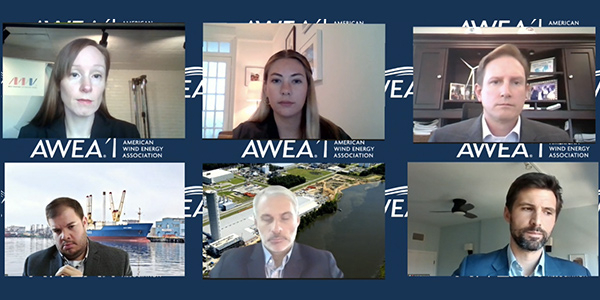Permits are the first things needed to continue developing a sustainable supply chain for the U.S. offshore wind industry. All else flows from that starting point, a panel told the American Wind Energy Association’s Offshore Windpower Virtual Summit on Wednesday.
“I’m tired of talking about potential; I want to talk about actual … and for that we need certainty and transparency,” said Aaron Smith, CEO of the Offshore Marine Service Association (OMSA), based in New Orleans.
Any time the U.S. maritime industry has had certainty and transparency, it has built and even overbuilt to the market need, from launch barges, to multipurpose supply vessels, to LNG carriers, Smith said.
“Every time there’s certainty and transparency, we have built to that market, but you need to have that transparency, and you need to have that certainty, and the first step to getting there is to have those permits being issued,” Smith said. “Permits equal certainty, equal a supply chain. So, that’s what we need to see. If we can have the certainty in investment, then we can capitalize on it.”
The first big OSW project in the permitting pipeline is the 800-MW Vineyard Wind project south of Martha’s Vineyard off Massachusetts, on which the U.S. Bureau of Ocean Energy Management expects to issue a final decision in December. (See Developers Seek 1-Mile Spacing for Vineyard Wind.)
Emmanuel Martin-Lauzer of Nexans High Voltage USA agreed with Smith, saying the U.S. market is difficult for investors to put money into without timely and predictable permits.
Despite the very slow start in the U.S. compared to Europe, Nexans, which has several offices around the country and in Canada, is adding submarine cable manufacturing capability to its existing facility in South Carolina.
Jones Act and More
OSW supply chain factors other than permitting include workforce training, the Jones Act requirement that vessels working coastal trade be built in the U.S., local content requirements, and the potential of benefiting from oil and gas industry assets and experience.
Moderator Maria Ravn, U.S. global supply chain management lead at turbine manufacturer MHI Vestas Offshore Wind, relayed an audience question on how the lack of Jones-compliant vessels is affecting planning or projects timelines.
“Is it a known fact that there are no available large installation vessels for turbines and foundations, at least for the monopile foundations?” said Joris Veldhoven, treasurer and commercial director of Atlantic Shores Offshore Wind, a joint venture created by Shell New Energies and EDF Renewables to develop a lease area off New Jersey.
“I think that’s a reality that all the developers can work around and are working around; all the projects along the East Coast are certainly maturing their development plans in sight of this,” Veldhoven said. “It has the potential to be a gamechanger … but when it comes to local content, even beyond the offshore scope, a lot of local content development is going on in spite of this.”
Smith said the question appeared targeted to wind turbine installation vessel (WTIV) fleets, and that floating platforms and jack-up heavy-lift vessels — and vertical lifts — don’t need to be Jones-compliant.
When Danish shipping company Maersk applied to do the installations for Vineyard, for example, it was going to use a foreign-flagged ship being supplied by U.S. feeder vessels, “so, that is a perfectly legal way for these operations to happen; so, no, there is no impact,” Smith said. “Now, how do we ensure that we have the U.S. feeding vessels? I know of at least four different companies that are looking to invest in this space, but they need certainty.”
Shipowners and builders have not yet seen the certainty to invest in feeding vessels, and some wonder if there is going to be a strict adherence to the Jones Act on this matter, or if WTIVs would be used to transport and install turbines and foundations, Smith said.
Diversification and Training

Edward Anthes-Washburn, executive director of the New Bedford Port Authority, which hosts the main OSW terminal for the state of Massachusetts, said Gulf of Mexico infrastructure tailored to oil and gas drilling can be repurposed for OSW, and that companies are looking at the downturn in oil and gas as an opportunity to diversify.
“Especially right now, with the price of oil so low, they’ve been cutting in half the deep-water drilling operations, so there’s a lot of equipment,” Anthes-Washburn said. “In the U.S. market, there’s a lot of expertise that exists in the gulf, and that’s what our target will look like 10 years from now — it will be a combination of northern Europe and southern Louisiana.”
Nexans’ Martin-Lauzer said that repurposing the feeder barges and jack-up feeder barges developed in the gulf wouldn’t necessarily cost much more because those jack-up vessels are very expensive by the day, and using feeder vessels would actually minimize the amount of time the jack-up rig has to be offshore.
And the skills needed to run those vessels and operate the heavy machinery already exist in the Gulf, with “200 of 800 vessels out of action now because of the downturn in the oil and gas sector,” Smith said.
Emily Kuhn of The Renewables Consulting Group said the Northeast also has a skilled workforce, but that more people will be needed for an estimated $80 billion in OSW construction contracts over the coming decade, and the sooner people can start being trained for such jobs, the better.
“So that when the time comes, we don’t have a non-U.S. labor force coming in and taking the jobs … training can help make the U.S. on a par with more experienced workforces around the world,” Kuhn said. “The jobs will follow the infrastructure and … the jobs do not end up moving to Europe.”







